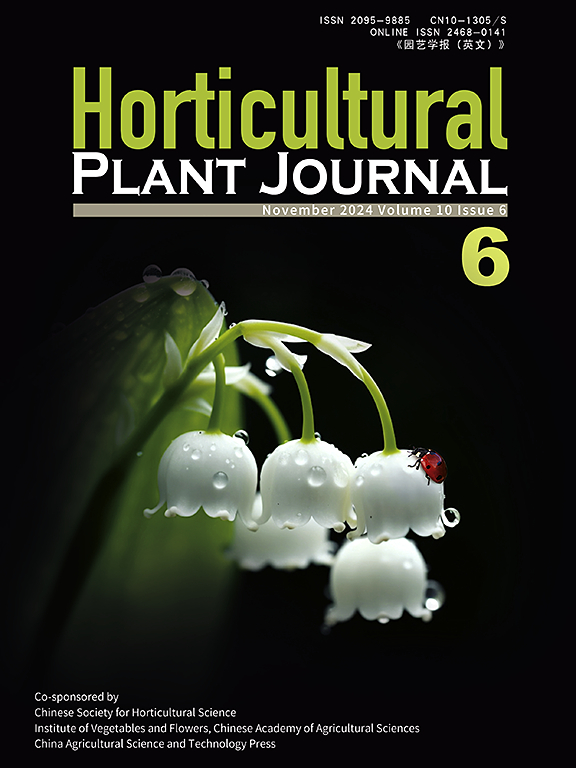CmaGA2ox2基因与冬瓜矮秆结构有关,该基因由CmaDw-1显性基因座控制
IF 6.2
1区 农林科学
Q1 HORTICULTURE
引用次数: 0
摘要
矮秆或半矮秆的植株结构以蔓节或节间长度缩短为特征,是冬瓜生产的理想性状,但这一性状的调控机制和特定基因尚不清楚。本研究对自交系Agol矮化表型(短藤长)的主要效应QTL进行了基于图谱的克隆和功能鉴定。在Agol背景下培育了一株携带野生型长茎等位基因的近等基因系SV105。两个NILs的比较组织学观察表明,矮化表型是由于茎伸长期间细胞伸长减少,因此节间长度减少。对nil衍生的分离群体的遗传分析证实,单个显性基因CmaDw-1控制矮化表型。大量分离分析和精细遗传定位鉴定CmaCh03G013990是编码赤霉素代谢关键酶——赤霉素2氧化酶2 (CmaGA2ox2)的CmaDw-1的唯一候选基因。序列分析显示,CmaGA2ox2的启动子和编码区存在多个单核苷酸多态性(snp)或插入/缺失(InDels),这些多态性与Agol茎伸长减少有关。CmaGA2ox2的时空表达分析揭示了其在NILs发育早期下胚轴中的差异表达。内源GAs和外源植物激素处理在NILs中的定量以及CmaDw-1在拟南芥中的异位表达进一步支持了CmaGA2ox2在茎伸长中的关键作用。这项工作提供了第一个分子的见解,以调节矮化植物的结构在C. maxima。本文章由计算机程序翻译,如有差异,请以英文原文为准。
CmaGA2ox2 is associated with dwarf plant architecture controlled by the single dominant CmaDw-1 locus in winter squash
Dwarf or semi-dwarf plant architecture characterized by reduced vine or internode length is a desirable trait for winter squash (Cucurbita maxima ) production, but the regulatory mechanisms and specific genes responsible for this trait remain unidentified. In this study, we conducted map-based QTL cloning and functional characterization of a major-effect QTL, underlying the dwarf phenotype (short vine length) in the inbred line Agol. A near-isogenic line, SV105 carrying the wildtype long-stem allele in Agol background was developed. Comparative histological observations in the two NILs indicated that the dwarf phenotype is due to reduced cell elongation, and thus internode length during stem elongation. Genetic analysis in NIL-derived segregating populations confirmed that a single dominant gene, CmaDw-1, controlled the dwarf phenotype. Bulked segregant analysis and fine genetic mapping identified CmaCh03G013990 as the sole candidate gene for CmaDw- 1 that encodes gibberellin 2-oxidase 2 (CmaGA2ox2), a key enzyme in gibberellin (GA) metabolism. Sequence analysis revealed multiple single nucleotide polymorphisms (SNPs) or Insert/Deletions (InDels) within the promoter and coding region of CmaGA2ox2 that are associated with reduced stem elongation in Agol. Spatiotemporal expression analysis of CmaGA2ox2 revealed its differential expression in the hypocotyls between NILs in the early development stage. Quantitation of endogenous GAs and exogenous phytohormone treatments in NILs and ectopic expression of CmaDw-1 in Arabidopsis further support the critical role of CmaGA2ox2 in stem elongation. This work provides the first molecular insights into the regulation of dwarf plant architecture in C. maxima .
求助全文
通过发布文献求助,成功后即可免费获取论文全文。
去求助
来源期刊

Horticultural Plant Journal
Environmental Science-Ecology
CiteScore
9.60
自引率
14.00%
发文量
293
审稿时长
33 weeks
期刊介绍:
Horticultural Plant Journal (HPJ) is an OPEN ACCESS international journal. HPJ publishes research related to all horticultural plants, including fruits, vegetables, ornamental plants, tea plants, and medicinal plants, etc. The journal covers all aspects of horticultural crop sciences, including germplasm resources, genetics and breeding, tillage and cultivation, physiology and biochemistry, ecology, genomics, biotechnology, plant protection, postharvest processing, etc. Article types include Original research papers, Reviews, and Short communications.
 求助内容:
求助内容: 应助结果提醒方式:
应助结果提醒方式:


